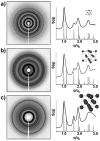Establishing the design rules for DNA-mediated programmable colloidal crystallization
- PMID: 20486143
- PMCID: PMC3039301
- DOI: 10.1002/anie.201000633
Establishing the design rules for DNA-mediated programmable colloidal crystallization
Abstract
The assembly of DNA-programmable colloidal crystals is presented, where the sizes of nanoparticles used vary from 5 to 80 nm and the lattice parameters of the resulting crystals vary from 25 to 225 nm. A predictable and mathematically definable relationship between particle size and DNA length is demonstrated to dictate the assembly and crystallization processes, creating a set of design rules for DNA-based nanoscale assembly.
Figures




Similar articles
-
DNA-programmable nanoparticle crystallization.Nature. 2008 Jan 31;451(7178):553-6. doi: 10.1038/nature06508. Nature. 2008. PMID: 18235497
-
Molecular recognition and self-assembly special feature: Assembly and organization processes in DNA-directed colloidal crystallization.Proc Natl Acad Sci U S A. 2009 Jun 30;106(26):10493-8. doi: 10.1073/pnas.0900630106. Epub 2009 Jun 19. Proc Natl Acad Sci U S A. 2009. PMID: 19549828 Free PMC article.
-
Altering DNA-Programmable Colloidal Crystallization Paths by Modulating Particle Repulsion.Nano Lett. 2017 Aug 9;17(8):5126-5132. doi: 10.1021/acs.nanolett.7b02502. Epub 2017 Jul 21. Nano Lett. 2017. PMID: 28731353
-
Programmable Matter: The Nanoparticle Atom and DNA Bond.Adv Mater. 2022 Mar;34(12):e2107875. doi: 10.1002/adma.202107875. Epub 2022 Feb 6. Adv Mater. 2022. PMID: 34870875 Review.
-
The relevance of light in the formation of colloidal metal nanoparticles.Chem Soc Rev. 2014 Apr 7;43(7):2089-97. doi: 10.1039/c3cs60256g. Epub 2013 Sep 23. Chem Soc Rev. 2014. PMID: 24056824 Review.
Cited by
-
Immunopods: polymer shells with native antibody cross-links.Angew Chem Int Ed Engl. 2012 Jan 27;51(5):1169-72. doi: 10.1002/anie.201106313. Epub 2011 Dec 15. Angew Chem Int Ed Engl. 2012. PMID: 22173847 Free PMC article. No abstract available.
-
Nanoparticle Superlattices: The Roles of Soft Ligands.Adv Sci (Weinh). 2017 Sep 6;5(1):1700179. doi: 10.1002/advs.201700179. eCollection 2018 Jan. Adv Sci (Weinh). 2017. PMID: 29375958 Free PMC article. Review.
-
Relevance of packing to colloidal self-assembly.Proc Natl Acad Sci U S A. 2018 Feb 13;115(7):1439-1444. doi: 10.1073/pnas.1720139115. Epub 2018 Jan 30. Proc Natl Acad Sci U S A. 2018. PMID: 29382766 Free PMC article.
-
Non-equilibrium anisotropic colloidal single crystal growth with DNA.Nat Commun. 2018 Nov 1;9(1):4558. doi: 10.1038/s41467-018-06982-9. Nat Commun. 2018. PMID: 30385762 Free PMC article.
-
Self-Assembly of DNA-Grafted Colloids: A Review of Challenges.Micromachines (Basel). 2022 Jul 14;13(7):1102. doi: 10.3390/mi13071102. Micromachines (Basel). 2022. PMID: 35888919 Free PMC article. Review.
References
Publication types
MeSH terms
Substances
Grants and funding
LinkOut - more resources
Full Text Sources
Other Literature Sources

